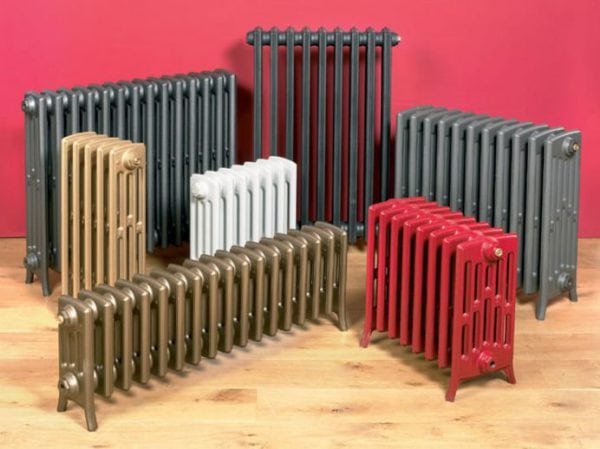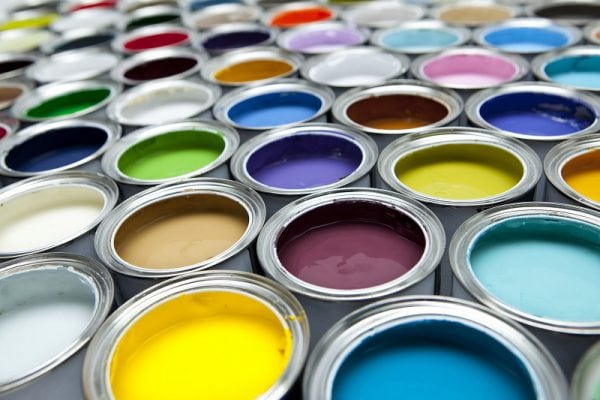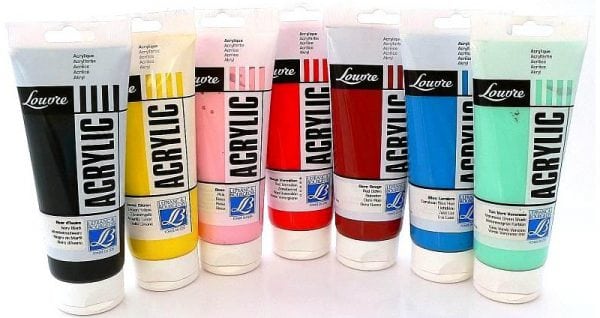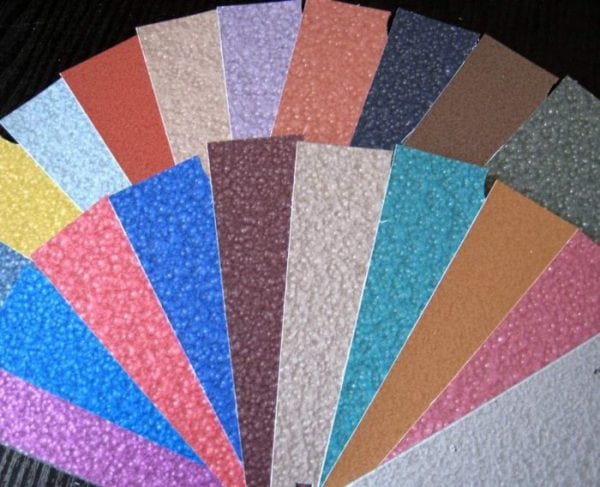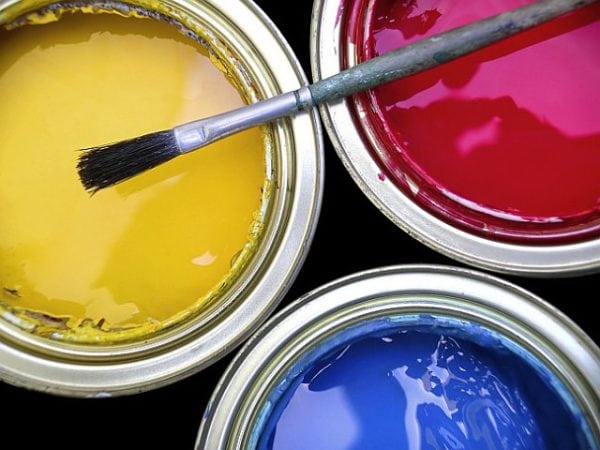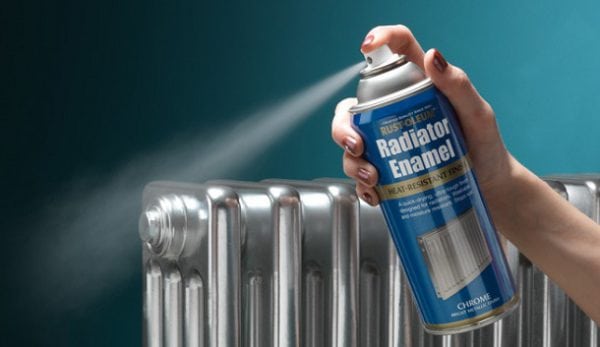During any cosmetic repairs or after replacing the heating system, it becomes necessary to paint the batteries. Conventional varnishes and enamels are not suitable here, because when heated during the heating season, cracking of the decorative coating is possible. Here we need a special paint for batteries with heat resistance determined by GOST. Which dye is better to choose and how to apply it correctly?
- Odorless paint selection
- Acrylic paints
- Hammer paints
- Not recommended types of paints
- Acrylic stain
- Preparatory Activities
- Dyeing
- Some useful tips
- Hammer painting
- Dyeing
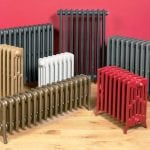
Previously, the same enamels used to paint the floor or window were used to paint heating systems. The service life of such a coating was short because of exposure to high temperatures, and it did not protect the metal well from corrosion. Now paint and varnish factories produce special heat-resistant paint for radiators that meets the necessary requirements.
In the process of staining, most paints emit an unpleasant odor. This is due to the fact that organic solvents are present in such paints and varnishes. Nevertheless, paints devoid of pungent odors are also on the market. Odorless paint for radiators is usually a water-based compound.
to contents ↑Odorless paint selection
There are two types of water based paints:
- water emulsion (liquid polymer in a liquid solvent);
- water-dispersible (solid polymer in a liquid solvent).
Also gaining in popularity hammer paints. They are characterized by the absence of a pungent odor, despite the presence of an organic proprietary solvent in the composition.
The paintwork for painting radiators or plumbing pipes must meet certain basic requirements:
- resistance to elevated temperatures;
- increased resistance to mechanical influences;
- ability to resist aggressive liquids when cleaning a surface;
- good water repellent.
It is also desirable that the paint does not produce unpleasant odors during its application and during operation of the painted surface.
The following types of paints are distinguished by the absence of pungent odors:
- acrylic;
- hammer.
For aluminum radiators, if there is a need for their coloring, it is better to use enamels in cans. Enamels perfectly fit on an aluminum surface, have great heat resistance and thermal conductivity.
to contents ↑Acrylic paints
In addition to the absence of unpleasant odors, water-based acrylic paints have many advantages:
- durability, resistance to wear;
- fire safety;
- good covering ability and low consumption;
- drying speed;
- ease and safety of application;
- leachability of non-dried composition;
- beautiful glossy look;
- high resistance to moisture.
Disadvantages of acrylic paints:
- slight adhesion in the absence of soil;
- some types of paints greatly change their qualities during drying (color, gloss).
to contents ↑Note! If acrylic paint is based not on a water base, but on an organic solvent, an unpleasant odor when applying the paintwork material and drying it cannot be avoided.
Hammer paints
Hammer coatings belong to decorative enamels, upon application of which rough relief surfaces are formed. Externally painted surface resembles chasing obtained as a result of hammer blows on the material.
In the manufacture of hammer coatings, acrylates, epoxies, alkyds, silicone and styrene are used. Also, the composition of hammer mixtures includes small-fraction glass, aluminum powder and metal pigments.
Due to its composition, hammer mixtures are characterized by a wide range of positive properties:
- lack of strong smell;
- resistance of the painted surface to high temperatures (up to 80 degrees and above);
- excellent adhesion;
- high resistance to external influences (humidity, mechanical stress);
- high density of coatings, the consequence of which is increased resistance to corrosion processes;
- quick drying;
- a variety of color palette;
- color fastness;
- dirt-repellent qualities;
- even rust can be painted without first cleaning the surface.
The main disadvantage of hammer mixtures is their high cost.
to contents ↑Not recommended types of paints
Unpleasant odors emit the following types of paints:
- Alkyd. In alkyd-based paints and varnishes, organic solvents are used as a solvent, so an unpleasant odor is characteristic of such compositions. Moreover, the smell is released not only upon drying, but also under the influence of elevated air temperature.
- Oil. There are no oil compounds without a pungent odor. Some manufacturing companies manage to make this smell a little less strong, but nothing more.
- Silicate. This type of paint is specially designed for high temperatures. However, the smell disappears for a very long time. They canpaint pipes and radiators in houses under construction.
- Serebryanka. It contains petroleum products, and therefore odors can not be avoided.
Acrylic stain
The work of painting radiators consists of two stages: preparation and application of paint.
Preparatory Activities
In order for the applied coating to retain its properties as long as possible, it is necessary to carefully prepare the surface. Moreover, preparation usually takes longer than applying paint.
Instructions for preparing the surface:
- Remove dirt and dust with a damp cloth.
- Remove the old coating. This can be done using a metal brush or chemical solvent.
- To remove paintwork residues, we apply a washing solution to the cleaned surface. We wrap the battery in a film for a couple of hours. We remove the remnants of the paintwork with a spatula.
- Level the surface with an emery cloth.
- Apply a primer. It is best to give preference to anti-corrosion composition.
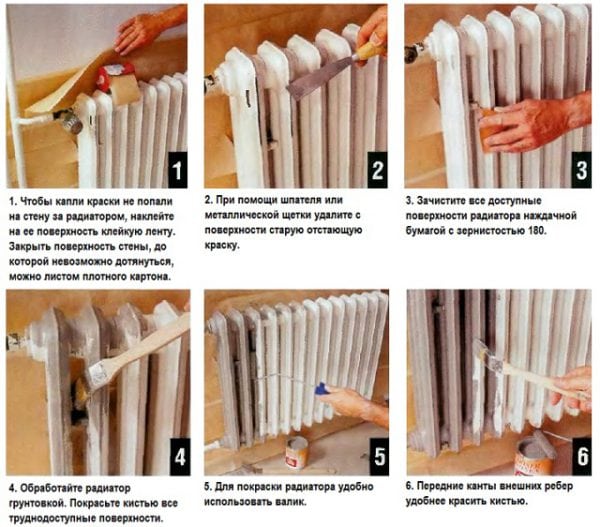
Dyeing
When the primer is dry, you can start applying the paint. The following is the sequence of actions:
- We cover the floor with film, rags or paper to protect it from accidental contact with paintwork materials.
- When staining, we use two brushes - one of them is of a straight shape, and the other is curved (for hard-to-reach areas).
- Apply paint from the top of the radiator to the bottom. We begin to paint from hard to reach places, gradually moving to the outside of the battery.
- After drying the first layer (time is indicated by the manufacturer on the packaging), apply the second.
Some useful tips
- In the process of painting and drying, radiators and pipes must be cold. Otherwise, the paint will dry unevenly. Based on this requirement, it is best to paint before the heating season.If the work is carried out in the cold season, you can ask the ZhEK employees to temporarily shut off the hot water supply.
- There are special formulations on the market that can even be applied on hot surfaces (e.g. fire retardant mixtures). However, prices for such coatings are markedly higher than usual.
- The fastest way to apply paint is with a spray gun. However, this option is fraught with paintwork on unwanted places. Therefore, it is recommended to use a spray gun in situations where nearby surfaces have yet to be finished.
- When it comes to painting electric radiators, it is recommended to use Zinga conductive paint. This composition is distinguished by excellent characteristics, and also protects against accidental electric shock when the radiator breaks down.
- Do not apply too much paint if additional coatings are planned. This approach will prevent the formation of sagging and uneven drying.
Hammer painting
Preparatory work:
- If there are traces of grease on the radiator, remove them with a solvent (solvent or mineral spirits). After that, we additionally wipe the surface with acetone.
- We process the material with sandpaper or a metal brush. This will improve the adhesive properties of the metal.
- The hammer composition can be applied to any type of paint and varnish coatings (with the exception of powder and bitumen coatings). However, obviously peeling paint is removed, and then we wash the surface with washing powder.
- We rinse the surface with clean water and allow the metal to dry well.
- Although hammer formulations can be applied to corroded metal, excessively loose rust is removed with a metal brush.
Dyeing
Hammer mixture can be applied at temperatures ranging from 10 to 25 degrees above zero. The maximum permissible air humidity is not more than 85%. Apply the paint using a brush, roller or spray can.
Note! The layer thickness should be at least 100 microns. Such a layer will provide reliable protection against corrosion.
When painting with a brush, 2-3 layers of paint will be needed. Particular attention should be paid to applying paint on the corners and edges of the radiator, since it is these places that are most susceptible to rusting of iron. If the surface has a complex relief, it is advisable to move the radiator to a horizontal position, and increase the number of layers to 3-4.
It is more convenient and faster to use a roller with large and even surfaces. It is recommended to use a short-haired fur or wool roller.
Staining with an aerosol spray is recommended only for processing small surface areas when you need to paint over any defect. If the entire radiator is painted from a spray gun, there is a high risk of staining the room.
Before starting work, the can should be shaken for 3 minutes, until a knock is heard that resembles the sound from the impact of the ball.
It is recommended to apply 3-4 coats of paint, since it is difficult to control the consumption of paint and varnish material in the case of a spray gun. The optimal distance from the spray can to the work surface is 15-20 centimeters. Already 2-3 minutes after applying the first layer, you can apply the second. However, the third and fourth layers can be applied only after 15-20 minutes after applying the previous one.
Painting batteries, like any other construction operation, requires a responsible attitude. If there is no self-confidence or if there are doubts about the choice of enamel, you can always turn to professionals for help. Although in general, dyeing heating devices is not considered difficult work and can be done independently even by a person with no experience.

